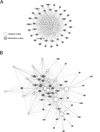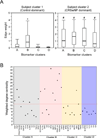Immunological profiling in chronic rhinosinusitis with nasal polyps reveals distinct VEGF and GM-CSF signatures during symptomatic exacerbations
- PMID: 25429844
- PMCID: PMC4459602
- DOI: 10.1111/cea.12463
Immunological profiling in chronic rhinosinusitis with nasal polyps reveals distinct VEGF and GM-CSF signatures during symptomatic exacerbations
Abstract
Background: The mechanisms and immune pathways associated with chronic rhinosinusitis (CRS) are not fully understood. Immunological changes during acute exacerbation of CRS may provide valuable clues to the pathogenesis and perpetuation of the disease.
Objective: To characterize local and systemic immune responses associated with acute worsening of sinonasal symptoms during exacerbation in CRS with nasal polyps (CRSwNP) compared to controls.
Methods: This was a non-interventional prospective study of individuals with CRSwNP and normal controls. Subjects underwent a baseline visit with collection of nasal secretions, nasal washes, and serum specimens. Within 3 days of acute worsening of sinonasal symptoms, subjects underwent a study visit, followed by a post-visit 2 weeks later. The sinonasal outcome test-22 (SNOT-22) scores and immunological parameters in the specimens were analysed using a novel, unsupervised learning method and by conventional univariate analysis.
Results: Both CRSwNP patients and control subjects showed a significant increase in SNOT-22 scores during acute exacerbation. Increased nasal levels of IL-6, IL-5, and eosinophil major basic protein were observed in CRSwNP patients. A network analysis of serum specimens revealed changes in a set of immunological parameters, which are distinctly associated with CRSwNP but not with controls. In particular, systemic increases in VEGF and GM-CSF levels were notable and were validated by a conventional analysis.
Conclusions: CRSwNP patients demonstrate distinct immunological changes locally and systemically during acute exacerbation. Growth factors VEGF and GM-CSF may be involved in the immunopathogenesis of subjects with CRS and nasal polyps experiencing exacerbation.
Keywords: Chronic rhinosinusitis; GM-CSF; VEGF; exacerbation; human rhinovirus; nasal polyposis.
© 2014 John Wiley & Sons Ltd.
Figures








Comment in
-
Profiling the immunological characteristics of exacerbation of chronic rhinosinusitis with nasal polyps.Clin Exp Allergy. 2015 Apr;45(4):704-5. doi: 10.1111/cea.12499. Clin Exp Allergy. 2015. PMID: 25800690 No abstract available.
References
-
- Meltzer EO, Hamilos DL, Hadley JA, Lanza DC, Marple BF, Nicklas RA, Bachert C, Baraniuk J, Baroody FM, Benninger MS, Brook I, Chowdhury BA, Druce HM, Durham S, Ferguson B, Gwaltney JM, Kaliner M, Kennedy DW, Lund V, Naclerio R, Pawankar R, Piccirillo JF, Rohane P, Simon R, Slavin RG, Togias A, Wald ER, Zinreich SJ American Academy of Allergy, Asthma and Immunology (AAAAI); American Academy of Otolaryngic Allergy (AAOA); American Academy of Otolaryngology--Head and Neck Surgery (AAO-HNS); American College of Allergy, Asthma and Immunology (ACAAI); American Rhinologic Society (ARS) Rhinosinusitis: establishing definitions for clinical research and patient care. The Journal of allergy and clinical immunology. 2004;114:155–212. - PMC - PubMed
-
- Bhattacharyya N. Contemporary assessment of the disease burden of sinusitis. American journal of rhinology & allergy. 2009;23:392–395. - PubMed
-
- Payne SC, Borish L, Steinke JW. Genetics and phenotyping in chronic sinusitis. The Journal of allergy and clinical immunology. 2011;128:710–720. - PubMed
-
- Hopkins C, Gillett S, Slack R, Lund VJ, Browne JP. Psychometric validity of the 22-item Sinonasal Outcome Test. Clinical otolaryngology. 2009;34:447–454. - PubMed
Publication types
MeSH terms
Substances
Grants and funding
LinkOut - more resources
Full Text Sources
Other Literature Sources
Medical

